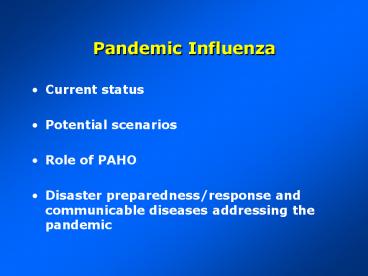Pandemic Influenza - PowerPoint PPT Presentation
1 / 41
Title:
Pandemic Influenza
Description:
Disaster preparedness/response and communicable diseases addressing the pandemic ... health sector network of epidemiologists, disaster coordinators, health services, ... – PowerPoint PPT presentation
Number of Views:44
Avg rating:3.0/5.0
Title: Pandemic Influenza
1
Pandemic Influenza
- Current status
- Potential scenarios
- Role of PAHO
- Disaster preparedness/response and communicable
diseases addressing the pandemic
2
Pandemic Influenza
- Annual Influenza
- Avian Influenza
- Pandemic Influenza
H1-16 N1-9
3
Influenza epidemics and pandemics
4
Requirements for emergence of a pandemic
influenza strain
- Total lack of immunity in world population
- Be able to cause disease in humans
- Efficient person-to-person transmission of the
virus
5
Avian Influenza
6
(No Transcript)
7
8
(No Transcript)
9
(No Transcript)
10
H5N1 Wild Bird Flu OutbreaksFebruary 2006
11
H5N1 Wild Bird Flu OutbreaksFebruary 2006
12
Avian Influenza H5N1
13
(No Transcript)
14
(No Transcript)
15
(No Transcript)
16
(No Transcript)
17
Worldwide occurrence of newly infected countries
with H5N1 in 2006(including date of 1st official
notification to OIE)
- Cameroon (13/MAR/2006)
- Afghanistan (10/MAR/2006)
- Pakistan (03/MAR/2006)
- Serbia Montenegro (02/MAR/2006)
- Hungary (01/MAR/2006)
- Niger (28/FEB/2006)
- Azerbaijan (27/FEB/2006)
- Switzerland (26/FEB/2006)
- Slovakia (24/FEB/2006)
- Malaysia (23/FEB/2006)
- Bosnia Herzegovina (20/FEB/2006)
- Egypt (19/FEB/206)
- India (18/FEB/2006)
- France (17/FEB/2006)
- Germany (06/FEB/2006)
- Iran (14/FEB/2006)
- Greece (13/FEB/2006)
- Bulgaria (12/FEB/2006)
- Slovenia (12/MAR/2006)
- Italy (11/FEB/2006)
- Nigeria (08/FEB/2006)
- Iraq (02/FEB/2006) Included Human Cases
18
(No Transcript)
19
(No Transcript)
20
(No Transcript)
21
Human cases of Avian Influenza
22
Cumulative Numbers of Confirmed Human Cases of
Avian Influenza A/H5N1 A (H5N1) Reported to WHO
March 10, 2006
WHO reports only laboratory-confirmed cases.
23
Status of National Influenza Pandemic
Preparedness Plans in the Americas
Finalized
Draft
In progress
24
Potential scenarios
25
Expected deaths in LAC due to pandemic influenza
8-week outbreak scenario 1968
26
Expected deaths in LAC due to pandemic
influenza8-week outbreak scenario 1918.
27
(No Transcript)
28
Avian Influenza Economic implications
Major Global poultry exporters, 2004
Source USDA, JM Ovalle
29
Potential Impact of Avian Influenza in LAC
- Population at risk
- 600 million people in LAC
- 194 million people living in rural areas
- 5 billion domestic birds in LAC
- Economy
- Poultry production (around US 18,5 billion
dollars). - Egg production (around US 5 billion dollars).
- Imposition of barriers to commerce.
- Food Safety
- Poultry comprises 40 of the animal protein
consumed in the Region. - Employment in poultry production chain
- Environment (carcass disposal)
- Tourism
- The tourism sector in the Caribbean contributes
to
31 for the
Gross Domestic Product and employs 500,000 people.
30
(No Transcript)
31
Start of a Pandemic
32
Start of a pandemic
- Once the first cases of pandemic flu are
reported, countries will probably declare public
health alert or emergency - Countries with validated and rehearsed pandemic
plans will be in best position to make decisions
and take actions rapidly.
33
Spread
- It may not be possible to stop a pandemic once it
begins - The pandemic virus can spread rapidly causing
outbreaks around the world affecting up to 30 of
the population. - Better hygiene, nutritional status, and drugs can
mitigate some of the impact but international
spread could be more rapid than previous
pandemics.
34
Pandemic scenario
- Lack of vaccines in the first several months.
- Health services overwhelmed by public seeking
medical assistance if they present typical
influenza like symptoms and other severe and
life-threatening complications. - Many countries will need to convert health
services, including emergency and intensive care
units for increased demand. - There may be a need to temporarily close schools,
grocery stores and other public gathering places
and facilities. - Reduced capacity in essential services as
health-care, law enforcement, transportation due
absenteeism. - Not enough antiviral drugs to protect all
citizens. Drug delivery may create conflicts.
35
PAHOs actions
- PAHO Director established an inter-programmatic
and multidisciplinary Task Force on Epidemic
Alert and Response - Advise, Enable, Coordinate, and Monitor
- PAHO activities for influenza pandemic
preparedness and response - Implementation of the International Health
Regulations in the Region - Responsible for drafting the PAHO Strategic and
Operational Plan for responding to pandemic
influenza
36
Task Force on Epidemic Alert Response
37
National Influenza Centers (NICs) in the Americas
25 NICs in the Region
Countries with multiple NICs
Labs that are not NICs but send samples to CDC
Source Flunet
38
Strengthening Epidemiologic Surveillance
Capacities
- Active involvement of the Influenza related WHO
Collaborating Centers and National Influenza
Centers in the Global Influenza Network - Training in surveillance and diagnosis of
influenza viruses - Support NICs for viral characterization
- Supply of reagents for Influenza virus diagnosis
39
Strengthening national capacity
- Increase national, subregional and regional
awareness on pandemic influenza and other health
related emergencies and disasters. - Meetings and workshops on pandemic influenza for
health sector network of epidemiologists,
disaster coordinators, health services,
veterinary health and others. - Development of pandemic influenza table top
simulation exercises including health and other
key roles as agriculture, civil protection,
tourism, transportation, foreign affairs, Red
Cross, etc.
40
Regional and national emergency response
- Key activities
- Execute the PAHO Contingency Plan
- Activate EOC at PAHO HQ and in Country Offices.
- Mobilize multisectoral capacity for quick
readiness and response. - Mobilize Emergency Response Teams.
- Mobilization of financial resources for pandemic
response. - Implement emergency logistic procedures and
mechanisms.
41
Pandemic Influenza
- Challenge
- and
- Opportunity































